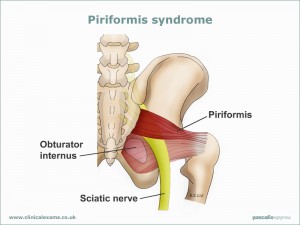
Piriformis syndrome is a pain in the butt that occurs when the piriformis muscle pushes on the sciatic nerve.
This is different from sciatica which originates from somewhere in the lower back.
The sciatic nerve actually forms directly in front of the piriformis muscle.
Five nerve roots come down from the spinal cord and through the pelvis and meet in front of the piriformis to form two nerves—the peroneal and the tibial—which are encased in a sheath creating the sciatic nerve, which at that exact spot, can be as thick as your index finger.
My main take on posture is that too many people let their pelvis lean forward which contracts the gluteus maximus and in turn the piriformis muscles.
Not everyone who does this suffers from piriformis syndrome but getting the legs under the pelvis can profoundly help those that do.
I have written many times that we are tight assed people and we need to let go.
Everyone needs to relax their butt (in my professional opinion) but piriformis syndrome sufferers need to prioritize doing so more than others.
Walking with the thighs forward has a similar effect on the piriformis muscle as well.
When we walk like this the legs are forced forward and we move through the outsides of the feet which keeps the piriformis in a constant state of external rotation.
While one of the functions of the piriformis muscles is external rotation they are not meant to do that constantly which is what happens with poor walking patterns.
Standing with the pelvis in a neutral position, and the legs underneath, allows the piriformis to broaden to its natural length but a gripped butt shortens the piriformis creating an environment where piriformis syndrome is more likely to occur.
All the doctors, cortisone, or bodyworkers in the world won’t help you escape the grip of piriformis syndrome if you don’t address your postural and walking patterns.
Piriformis syndrome is a pain in the butt from which you should be able to find permanent relief but you will likely have to change some long-held patterns to do so.
